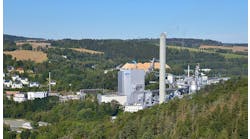THERE'S A LIMIT to the complexity of the control strategy harried human operators can manage. In a well field, this typically leads to using a simple reactive strategy, such as pumping water whenever required to maintain a constant reservoir level. The problem is that the strategy is inefficient and has a tendency to put a lot of strain on the wells and operating equipment.
JEA, the water, sewer and electric utility provider in Jacksonville, Fla., addressed the problem by developing an expert system that applies the real-time rule logic of human experts to drive several optimizers and models. It provides a sophisticated strategy that makes better use of wells and reservoirs by allowing water levels to rise and fall based on projected demand.
While other utilities are experimenting with this type of automated supervisory control, the JEA system may be the first to operate a production well field directly. The expert system and optimizer have already paid for themselves in a trial application in one well field where JEA has deferred $1.4 million in capital expenses. When the utility rolls the system out to one on its two major grids, it expects to save an estimated $170,000 per year in operating expenses and potential energy sale opportunities, and millions in capital expense deferrals.
JEA provides water service to over 250,000 customers with 100% of the supply coming from groundwater sources. The water supply comes from 39 well fields and associated treatment facilities, and the distribution network is divided into two major grids encompassing a four-county service area with 3,480 miles of water lines.
JEA has been challenged to reduce withdrawal of water from wells to meet tighter consumptive use permit limits, while raising the water quality and lowering operating costs.
Jacksonville, Fla., utility JEA has 39 well fields and 3,480 miles of water lines to manage. It optimizes its well-control strategy with a rules-based expert system from Gensym.
The previous well-control strategy could best be described as reactive. Wells were controlled as needed to maintain reservoirs at full levels. When demand was high, often wells were drawn down over time to levels that reduced their life. Another problem was that the vast majority of energy was consumed during daylight hours when JEA could sell it at a relatively high price. The previous control strategy also caused pumps to be frequently cycled on and off, which generated high maintenance expenses.
JEA took the lead in developing an automated software system for water supply and distribution that substantially improves water operations. EMA Inc. (ema-inc.com), a partner of the rules-engine vendor, Gensym, provided domain expertise and engineering services for the project.
Ideal Versus Real
Automating the entire water supply and distribution network required several different modeling and optimization technologies. But optimizers and models typically fall short in a real-time operational setting because they are grounded in an idealized world that doesn’t include upsets, discontinuities, changes in objectives, etc. JEA also had to address the challenge of integrating the various technologies, which required optimizing different elements of the supply and distribution system. The company selected Gensym’s G2 comprehensive rules-engine environment for managing the optimizer in real time. This platform integrates and coordinates the technology components and provides real-time event detection and condition diagnosis capabilities that significantly improve the stability and reliability of the overall control system.
JEA’s expert system calls a neural-network-based water consumption forecaster to provide hourly consumption forecasts for a specified time, typically 24 hours. The forecaster uses both linear and nonlinear models to predict water consumption based on factors such as historical consumption and weather forecasts. It applies a voting scheme to determine the most robust prediction, one that is not severely impacted by outliers. The total demand for water is allocated across the available sources of supply and then, based on the allocations, detailed schedules for treatment plants and well-field pumps are developed.
Both the distribution and supply optimization apply constraints gathered in real time to minimize distribution and well-field costs. Typical constraints include pump availability, pressure range, pump curve characteristics, flow capacity limits and transfer costs. Supply constraints include pump availability, reservoir level, individual well conductivity, consumptive use permits, pump starts/stops, well draw-down, pump total run time and energy cost profile.
JEA also developed a hydraulic model of its distribution system. The hydraulic model was calibrated using historical samples and real-time data from the JEA distribution network. The distribution optimization model uses a source-demand proximity strategy by which the closest plants serve the local consumption area, augmented by plants further away when necessary. This model includes a nonlinear objective function that allocates a sub-grid’s water demand to treatment plants and associated well fields, based on their capacities and the hydraulic properties of the pipes. The objective function is based on the Hazen-Williams equation, which relates energy consumption to flow through a pipe, and forces the optimizer to create hydraulically feasible solutions. The optimal flow profile for each plant is the set point for total flow through the high-service pumps at that plant. The distribution system has no storage, so pressures must be constantly monitored and controlled. A cascaded-flow pressure controller adjusts the pressure set point to drive flow to meet the optimal flow profile.
Optimize This!
The optimization strategy minimizes energy consumption during high-energy cost hours. The output of the model is a production schedule for each plant. The expert system specifies the combinations of well pumps to run at each hour and the order for running pumps across a 24-hour period for each well. This schedule is assessed each day and can be altered to meet changing conditions or constraints. Detailed pump operating schedules are transmitted directly to PLCs that run the well-field and high-service pumps. The supply optimizer generates stable operating schedules, reducing pumping during peak hours according to the cost-profile function, while maintaining the reservoir levels within the user-defined minimum and maximum values.
G2 makes managing an optimizer for closed-loop control practical by enabling work at a higher level of abstraction. JEA engineers defined inputs, such as sensors, and outputs, such as equipment set points, as software objects. They represented the rules-based logic for applying the optimizer calculations in an intuitive natural-language script that incorporates the concept of time. Typical optimization tasks, such as averaging the reading of a meter over time, checking a meter reading against mass balances, or checking the position of a pressure relief valve before changing a set point, were made parametrically without having to recode the algorithms.
Changes on the Fly
The expert system includes a user interface so operators can make adjustments to constraints and reporting. For example, operators can compare the projections against the actual reservoir levels. This same information is used by the expert system to adapt to changing conditions automatically. When the difference between the projected and actual reservoir level exceeds magnitude and rate-of-change criteria, a new set of constraints is captured, and a new schedule generated. This combination of feed-forward and feedback capabilities produces a highly adaptive control that makes the best use of forecasts and real-time events.
Well-field optimization was put into service less than eight weeks from project conception. The first sub-grid of the distribution system was ready for on-site testing and calibration six months after project conception.
The results in this sub-grid demonstrate that optimization makes better use of reservoir capacity by drafting, or lowering, levels as needed to minimize cost and maximize well quality. Well-field conductivity has been improved substantially, providing an indication that salt intrusion has been reduced, which will significantly improve water quality. Some wells have even shown a downward trend in conductivity, indicating that the health of these wells is increasing.
This application, when completed for JEA’s network of over 39 facilities, will enhance the company’s ability to service its growing customer base, reduce the need to invest in new wells and water mains, lower pumping energy costs, reduce equipment failures and minimize maintenance.
| About the Authors |




